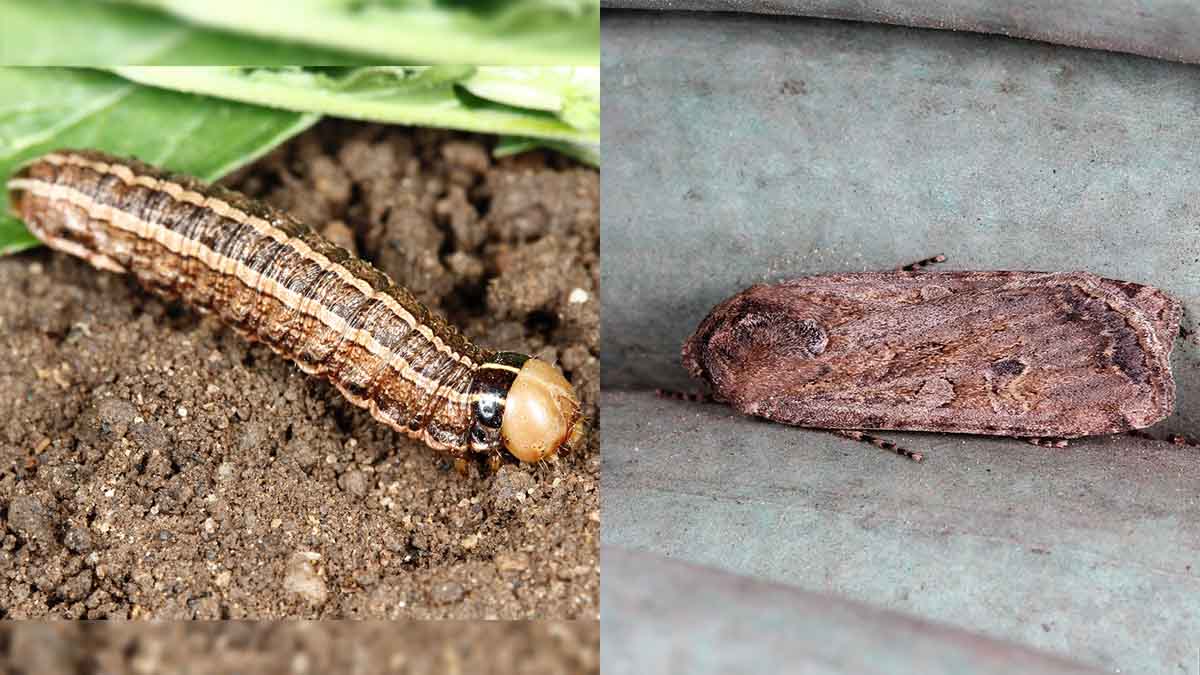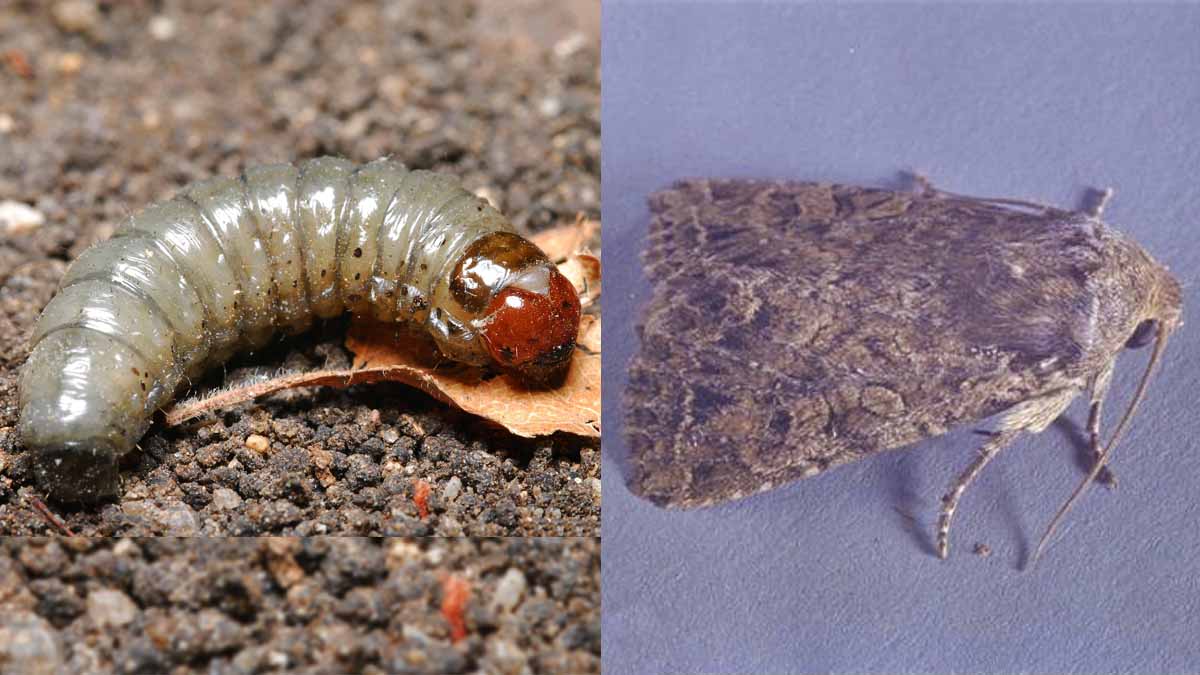Cutworms
Pest Common Name
- Army Cutworm (Euxoa auxiliaris)
- Black Cutworm (Agrotis ipsilon)
- Pale Western Cutworm (Agrotis orthogonia)
- Variegated Cutworm (Peridroma saucia)
- Glassy cutworm (Apamea devastator)
- Redbacked cutworm (Euxoa ochrogaster)
- Many others
- Crops: alfalfa (seed and hay), clovers, cereals, corn, potato, pulses (green and dry), sugar beet, oilseeds, pasture and grass hay, hops, mint, others
- Nearly all vegetables, many tree fruits and berries
- Landscaping, ornamentals and turfgrass
- Weeds: curly dock, lambsquarters, pigweed, others
Adult cutworms generally are mottled grey and brown moths, with wingspans ranging from 1 1/4-2 1/4 inches (30-56 mm). Larvae (caterpillars) are usually dull gray to dark brown, and range in length from 1/16-2 inches (1.5-50 mm), depending on the species and the stage. Larvae are generally smooth, with three pairs of legs near the head and five pairs of fleshy leg-like appendages near the posterior end. Cutworm larvae curl into a “C” shape when disturbed. Eggs are usually laid in clusters and vary widely in color depending on the species (Figures 1-5).





Biology
Some (e.g., redback cutworms) overwinter as eggs, and during very mild winters some (e.g., black cutworm) can also overwinter as pupae. However, most cutworms overwinter as larvae in the soil or under plant debris. Adults emerge anywhere between March and July, depending on the species. After emergence adults mate and lay eggs. Eggs generally hatch in four to seven days. Just-hatched larvae are tiny, but often remain in groups near the egg mass, and can skeletonize leaves or completely defoliate small seedlings. As they grow larger, they disperse within the same plant or travel to new host plants. In many species, larvae are nocturnal, feeding on foliage during the night, and at rest in cracks and crevasses in the soil during the day. In subterranean species, larvae feed on roots and stems, cutting plants off at the surface.
There are two overlapping generations of black and variegated cutworms per year, while army, pale western and glassy cutworm have just one generation per year.
Damage
Cutworms are primarily of concern during the spring and early summer, when they are most active and can inflict serious damage to young plants. In young plants in particular, cutworms can sever the stem or consume the entire shoot. Later in the season, cutworms can cause significant damage as they feed on plant leaves, leaving rough, irregular holes or causing complete skeletonization. Larvae can also bore into the bases of older plants. Occasionally, cutworm damage can be mistaken for slug damage, but whereas slug fecal deposits are sludge-like and slimy, cutworm fecal pellets are dry pellets (Figure 6).

Monitoring
Some cutworms be monitored with commercially available pheromone-baited traps that attract males. Keep in mind that pheromones target specific species, so consider what species are most likely to be problematic when selecting a lure. Larvae can also be monitored using a beat sheet or sweep net, though keep in mind that many species only actively feed during the night. Watching for cutworm pellets near defoliated plants can also be a useful monitoring tool.
Very few crops have formal economic treatment thresholds established for cutworms. When deciding if treatment is warranted, check the PNW Pest Management Handbooks website to see if guidelines exist. If no formal threshold exists, consider the vulnerability of the crop and the likelihood and severity of damage. Also consider that older plants can usually tolerate much more damage than younger plants before any economic damage is sustained. In some crops such as alfalfa as few as one larva per square yard can cause economic damage.
Management
Primary Management Tactics
Cultural Control
- Control weeds and grasses, and don’t allow debris to accumulate on the soil surface
- For home gardens and landscaping with a known cutworm infestation, going out at night and picking off larvae can reduce damage
- For home gardens, insert a popsicle stick into the soil directly at the base of the plant, so it is touching the stem, to prevent cutworms from circling/severing the stem
Biological
- Avoid using broad-spectrum insecticides to conserve natural enemies of cutworms, such as big-eyed bugs (Geocoris), damsel bugs (Nabis) and many species of ground beetle (Carabidae), rove beetle (Staphylinidae), and parasitic wasps and flies
- Many fungal pathogens are naturally occurring in the field and hold populations in check
- There are multiple biological insecticides (e.g., Bt and spinosad available, see the PNW Pest Management Handbooks website for more information
Chemical
- Consider spot treating infested sites, as cutworm infestations tend to be spotty and sporadic, often occurring near field margins or weedy patches
- Diatomaceous earth can reduce cutworm populations in home gardens and landscaping, though it needs to remain dry to be effective
- When possible, consider irrigating before treating for subterranean species such as the redback and army cutworm, as this brings larvae to the surface
- Foliar sprays are most effective at night, when most larvae are actively feeding
- Recommendations for pesticides to use in the management of armyworms can be found on the PNW Pest Management Handbooks website
Pesticide Warning
Always read and follow the instructions printed on the pesticide label. The pesticide recommendations in this University of Idaho webpage do not substitute for instructions on the label. Pesticide laws and labels change frequently and may have changed since this publication was written. Some pesticides may have been withdrawn or had certain uses prohibited. Use pesticides with care. Do not use a pesticide unless the specific plant, animal or other application site is specifically listed on the label. Store pesticides in their original containers and keep them out of the reach of children, pets and livestock.
Trade Names — To simplify information, trade names have been used. No endorsement of named products is intended nor is criticism implied of similar products not mentioned.
Groundwater — To protect groundwater, when there is a choice of pesticides, the applicator should use the product least likely to leach.
- Figure 1 & 5 (left). Joseph Berger, Bugwood.org
- Figure 2. Adam Sisson, Iowa State University, Bugwood.org
- Figure 3 (left). Frank Peairs, Colorado State University, Bugwood.org
- Figure 3 (right). John Capinera, University of Florida, Bugwood.org
- Figure 4. University of Georgia, Bugwood.org
- Figure 5 (right). Ken Gray, Insect Image Collection
- Figure 6. W.M. Hantsbarger, Bugwood.org
Desiree Wickwar, Entomologist, IPM Project Manager
2023












